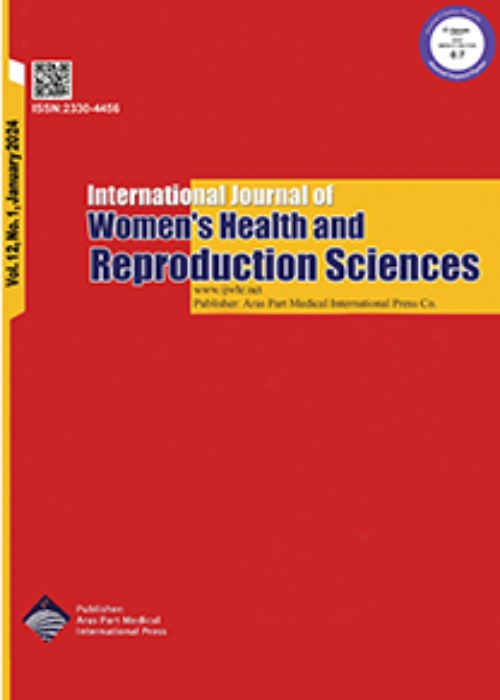فهرست مطالب
International Journal of Women’s Health and Reproduction Sciences
Volume:2 Issue: 1, Winter 2014
- تاریخ انتشار: 1393/04/20
- تعداد عناوین: 5
-
-
Pages 1-9ObjectivesWe aimed to evaluate the safety and efficacy of a transobturator sling (TOT) procedure by using an adjustable TOT device in the treatment of stress urinary incontinence (SUI).Materials And MethodsThe data of 89 patients who had the diagnosis of SUI and underwent TOT operation by using an adjustable MUS device of SAFYRE t plus (Promedon®) between June 2005 - November 2012, were retrospectively evaluated. The pateints were evaluted by the parametres of physical examination, stress test, ultrasonography, uroflowmetry, residual urine measurement, cystometry, subjective incontinence scoring (VASi), patient's satisfaction scoring (VASs), and ICQ-SF questionare. The preoperative, perioperative, and postoperative collected data were statistically analysed to determine the efficacy and safety of TOT application by using SAFYRE t plus.ResultsThe mean age, account of parity, and body mass index was 55.3±10.1, 2.34 ± 1.43, and 24.97 ± 3.7, respectively. While the pre- and postoperative results of stress test, VASi, and ICIQ-SF scores were significantly different (P=0.00 in all), the pre- and postoperative results of Qmax and PVR account were similar (P= 0.84, P= 0.79, respectively). The severity of subjective incontinence (VASi score) significantly improved after the operation. The mean VASs score at postoperative 12th month was 7.75±1.11. The subjective and objective cure rates were %89.9 (80/89) and %78.6 (70/89), respectively.ConclusionThe TOT operation by using SAFYRE t plus, which was an adjustable sling device, seemed to be an efficient, reasonably safe, minimally invasive treatment alternative for the surgical management SUI in women.Keywords: Adjustable Sling Device, Stress Urinary Incontinence, Transobturator Sling
-
Pages 10-16ObjectivesThe aim of the present study was to determine whether different anesthetic techniques applied for vaginal delivery and cesarean section affect neonatal bilirubin levels in the first 24 hours of life.Materials And MethodsA total of 511 neonates delivered by vaginal route or cesarean section were included in the study. The neonates were classified according to method of delivery and anesthetic agents as group A (cesarean section / general anesthesia with sevoflurane), group B (cesarean section / spinal anesthesia with bupivacaine hydrochloride), group C (vaginal delivery with episiotomy / local anesthesia with prilocaine hydrochloride) and group D (vaginal delivery/ no anesthesia). The levels of neonatal serum bilirubin in the groups were compared.ResultsThere was no difference between group A and group B in terms of neonatal bilirubin levels (p = 0.98). Depending on the use of prilocaine hydrochloride as local anesthetic agent in the vaginal delivery, there was no significant difference between the groups C and D, in terms of the neonatal bilirubin levels (p = 0.99). The serum levels of bilirubin in cesarean section groups were significantly higher than those of the vaginal delivery groups (p<0.001).ConclusionPrilocaine hydrochloride used for episiotomy did not exert any effects on neonatal hyperbilirubinemia. However, cesarean section with sevoflurane and bupivacaine hydrochloride seemed to result in increased bilirubin levels.Keywords: Anesthesia Technique, Neonatal Bilirubin Levels, Neonatal Hyperbilirubinemia
-
Pages 17-25ObjectivesThe aim of present study was to evaluate the awareness, attitude and participation of men in family planning program in Abyek, Iran.Materials And MethodsThis descriptive study was done on 400 men and women in Abyek, Iran. Data regarding awareness and attitude of men in family planning program and their participation rate were gathered. The descriptive statistics and Pearson correlation test were used for analyzing data.ResultsThe mean awareness, attitude and participation score of men in family planning was7.40±2.37, 54.68±6.12 and 8±2.52 respectively. The percentage of awareness, attitude and participation was 52.8%, 84% and 66.6% respectively. A significant relationship was observed between knowledge and participation (r=0.293, p=0.005) and attitude and participation (r=0.328, p=0.005).ConclusionAwareness and participation of men in family planning program was not good, however; their attitude was acceptable. It seems that the knowledge and practice of men about family planning should be increased by educational programs.Keywords: Attitude, Awareness, Family Planning Programs, Men, Participation
-
Pages 26-29ObjectivesCesarean section is a surgical procedure and it is performed when the normal vaginal delivery is not available or vaginal delivery is dangerous for mother or fetus. In other words, there are some special indications for cesarean section. In the past decade the rate of cesarean delivery in the absence of clear indications has increased. This subject suggests an intensive research and attention. This study has compared the causes of cesarean delivery among women.Material And Methods100 women who had referred to Shahid Madani Clinic in Marand city, were asked based on questionnaire that included information about patients and a list of causes that could lead women to a cesarean delivery.Thereafter,the contribution of each cause was assessed.ResultsFear of labor pain is the most common cause of cesarean delivery (35%) while having history of previous caesarean section, fear of disturbing the anatomy of external genitalia, medical indication for caesarean section and cultural beliefescaused with lower rate in comparsion to fear of labor pain. were placed in lower classes.ConclusionThis study showed that, several factors may lead women to caesarean delivery; The fear of labor pain is the most common factor that could be reduced by proper training and holding childbirth preparation classes for pregnant women.Keywords: Cesarean Section, Fear of Labor Pain, Indication of Cesarean Section
-
Pages 30-34Endometriosis is an estrogen dependent disease where active endometrial tissue is present in extra uterine sites. Presence of recurrent massive hemorrhagic ascites due to endometriosis is a rare phenomenon which can mislead physicians to other pathological conditions like malignancy and wrong treatment protocol may be applied. For confirming the cause of this huge bloody ascites laparoscopy or laparotomy followed by biopsy is significantly essential.Keywords: Endometriosis, Hemorrhagic Ascites


